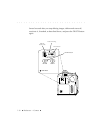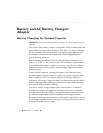
. . . . . . . . . . . . . . . . . . . . . . . . . . . . .
7-20 Reference — Camera
camera system. If the problem is with the PCMCIA card, you can try the
steps in the next paragraph.
The R
ECOVER button on the Camera Control panel of the software driver,
can be used in some circumstances while the camera is connected to a
computer to recover files that have been inadvertently deleted. In addi-
tion, since the PCMCIA card is in DOS format, it may be possible to
recover an image or sound file using PC utility programs, if available, with
file recovery features; doing so requires a separate PCMCIA card reader
since these programs cannot access the cards through the camera back. If
these actions are unsuccessful, you may need to format the card, an
operation which will erase all of your data on the card.
It is possible that a PCMCIA card may become fragmented, meaning that
files — such as the large image files — are broken into linked parts on
non-contiguous areas of the card. This can occur in several situations,
such as when small non-image files are stored in and among image files,
meaning that a large number of small unused areas are interspersed on the
card, rather than having all empty blocks together on one portion of the
card. Fragmentation can result, and if it does, it can result in slowed
camera performance.
If you believe this has occurred, you can delete all files on the card and/or
format the card — after saving files as desired to your computer hard disk.
You can also run a utility program (not supplied with the camera system)
with “defragger” capability that rearranges existing files into contiguous
areas of the PCMCIA card. This in turn frees large blocks on the card,
meaning that image files produced by the camera can be stored in a
single contiguous area — more efficient for file storage and retrieval.
Using a utility program requires a separate PCMCIA card reader since
these programs cannot access the cards through the camera back.


















